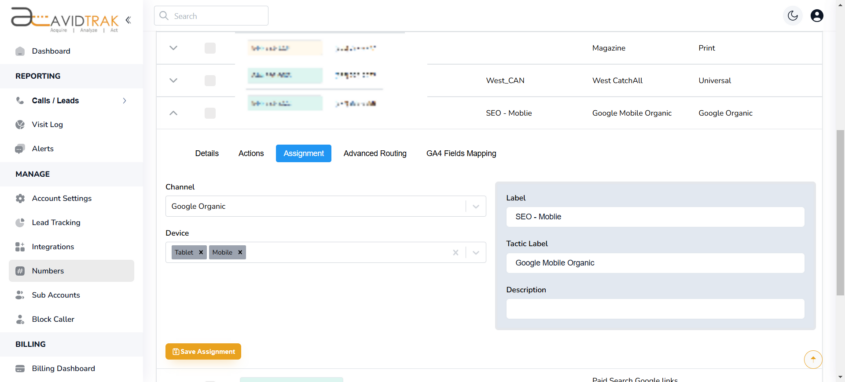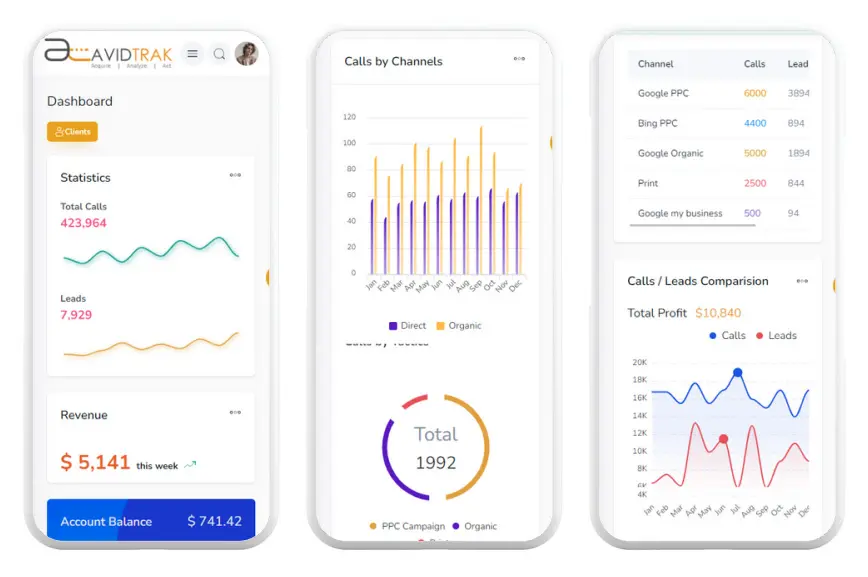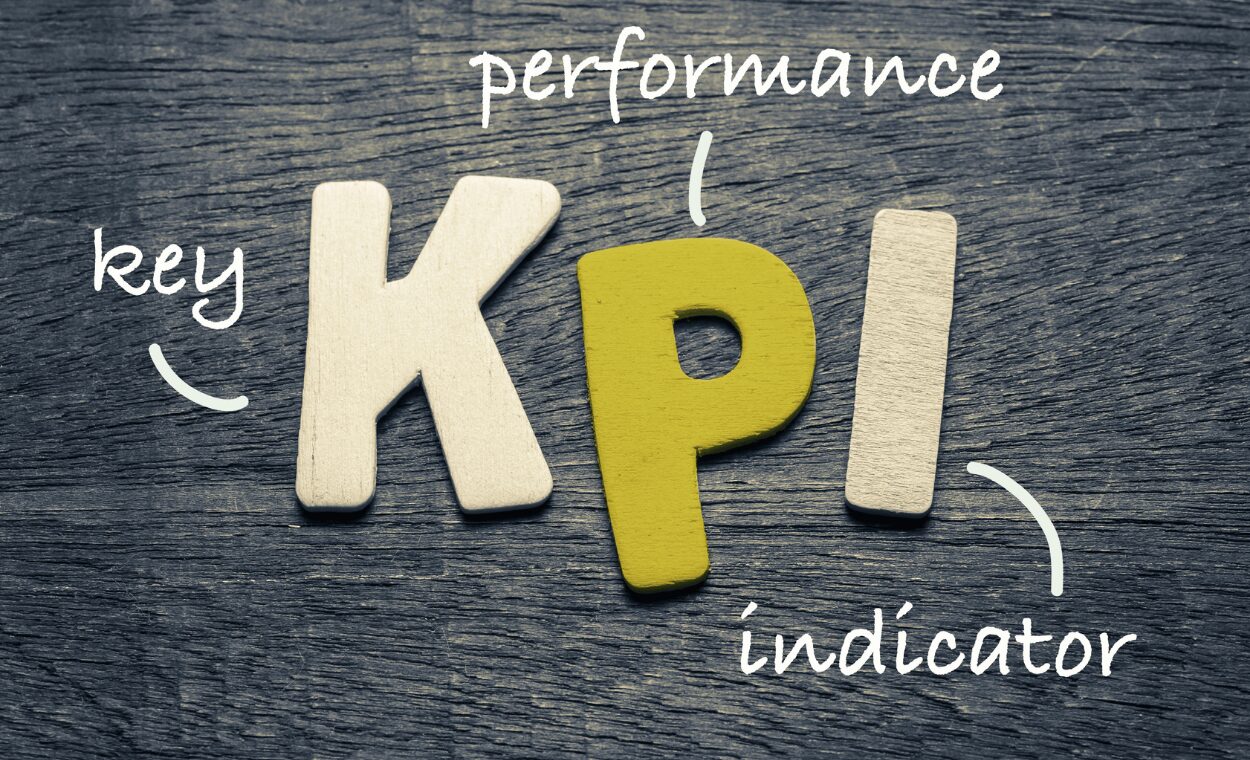A marketing touchpoint refers to any interaction a customer has with a brand before, during, or after a purchase. These interactions may include viewing a social media ad, clicking through a search engine result, visiting a landing page, or making a phone call to customer support. Each of these touchpoints plays a role in shaping the customer experience, building brand awareness, and influencing the final purchase decision.
A business must track these customer touchpoints to improve its marketing performance. Without visibility into what led a customer to act, a business risks overspending on low-performing marketing channels, missing leads, or delivering inconsistent communication.
Every touchpoint contributes to measurable outcomes such as Customer Satisfaction Score, brand loyalty, and Customer Lifetime Value.
AvidTrak gives businesses the tools to connect each call to the specific marketing activity that triggered the phone call. Features such as AI-powered transcription, call tracking, and attribution reporting allow marketers to pinpoint which campaigns are generating high-quality engagement.
A business that understands its touchpoints is better equipped to manage performance, improve the conversion rate, and deliver a consistent experience across all support channels.
Summary
- Marketing touchpoints encompass various interactions, including social media ads, landing pages, customer support calls, and email newsletters, each of which influences decisions at different stages of the customer journey.
- Tracking marketing touchpoints, especially those made via phone calls, is essential for identifying high-performing channels and avoiding wasted spend on tactics that do not convert.
- Touchpoints occur across the awareness, consideration, conversion, retention, and advocacy stages of the customer journey. Each stage requires specific tracking strategies to measure movement toward conversion.
- Key performance indicators for touchpoint marketing include engagement rate, conversion rate, Customer Lifetime Value, lead quality, and return on investment.
- Improving touchpoint performance depends on best practices such as message personalization, cross-channel consistency, automation, A/B testing, and integrated reporting.
- AvidTrak provides the foundation for effective touchpoint marketing. With transparent pricing, responsive support, and domain expertise in solving complex attribution problems, AvidTrak links every call to its source. Features such as call tagging, keyword-level tracking, and AI-powered transcription help turn conversations into data that drives smarter decisions.
Types of Marketing Touchpoints
Every customer decision is shaped by various stages in the journey, showing when interest builds, decisions are made, and where drop-offs happen.
Accurately tracking the customer journey, especially phone-based interactions, is where touchpoint marketing becomes useful. AvidTrak ties each customer interaction to the marketing strategy that triggered the contact, helping businesses focus on what actually drives results.
1. First Touchpoint (Awareness Stage)
Customers are first introduced to a brand through ads, search results, or TV placements that build initial awareness.
AvidTrak supports this stage through first-touch attribution. Each call generated by top-funnel strategies, such as paid ads or offline campaigns, is assigned a unique tracking number. When a prospect calls, AvidTrak connects that interaction to the specific campaign that created the initial interest.
2. Consideration Touchpoints (Engagement Stage)
During the engagement stage, customers visit product pages, compare options, read customer reviews, or interact on social media.
AvidTrak’s call tracking solution connects these engagements to phone calls using dynamic number insertion. Features such as AI-powered transcription and call tagging help identify common themes in customer questions and signals of interest.
3. Conversion Touchpoints (Decision Stage)
Conversion touchpoints include form submissions, demo requests, or calls to the sales team, often influenced by digital marketing content, email newsletters, or targeted ads.
AvidTrak tracks each call back to the marketing channel, keyword, and landing page that led to the action, helping to calculate the conversion rate and evaluate what drives results accurately.
4. Post-Purchase Touchpoints (Retention Stage)
The retention stage begins immediately after a purchase is made. Touchpoints, such as customer support calls, follow-up emails, and loyalty programs, have a significant impact on the overall customer experience and shape the Customer Satisfaction Score.
AvidTrak captures these calls with tools such as voicemail, call routing, and conversation AI. Keyword tagging highlights trends, allowing teams to monitor issues and track response quality across support channels.
5. Customer Advocacy Touchpoints (Loyalty Stage)
Advocacy touchpoints include referral programs, customer reviews, social sharing, and word-of-mouth recommendations to strengthen brand loyalty and public trust.
AvidTrak tracks repeated call behavior, linking it to referral campaigns and follow-up activity, identifying loyal customers and evaluating how advocacy contributes to future sales and brand engagement.
Key Performance Indicators (KPIs) for Marketing Touchpoints
Every marketing touchpoint must be evaluated with measurable data. Tracking the right KPIs allows businesses to understand which interactions lead to sales, which ones improve brand engagement, and which touchpoints create an emotional connection throughout the customer journey.
AvidTrak supports these measurement needs with tools that link calls to specific campaigns, keywords, landing pages, and behaviors. The following are key indicators that help marketers assess the performance of each touchpoint.
1. Engagement Metrics (Clicks, Views, Time Spent)
Early-stage metrics, such as click-through rate, page views, and time spent on site, indicate how effectively a marketing asset captures attention.
AvidTrak tracks phone calls triggered from website visits and connects them to the source of traffic. Whether the call originates from a company website page, a social media campaign, or an email, AvidTrak demonstrates how online interest translates into calls, providing a clearer view of user intent.
2. Conversion Rate and Sales Metrics
The most important outcome for many touchpoints is whether they lead to a conversion, which could be a form submission, a product purchase, or a direct call to the sales team.
AvidTrak’s attribution model maps each call to the specific mobile ad, channel, or keyword that influenced the action. Marketers can then compare which touchpoint marketing strategies are generating the highest conversion rate, helping refine the campaign mix across digital marketing content and offline ads.
3. Customer Retention and Repeat Purchases
Repeat customer behavior is closely tied to key metrics, including Customer Lifetime Value, return rate, and continued interaction through support channels or loyalty programs.
AvidTrak monitors recurring call patterns and tracks repeat engagements over time, helping businesses determine the effectiveness of their retention strategies and whether customer success programs are driving repeat calls from satisfied customers.
4. Call Attribution and Lead Quality
Service-based businesses often rely on phone calls as their primary means of conversion. Measuring lead quality through call duration, caller intent, and call outcomes helps identify which touchpoints are producing qualified leads, not just volume.
AvidTrak helps evaluate lead quality through tools such as lead scoring and call tagging. Keyword detection and whisper prompts give context to conversations, while caller activity logs and source-level attribution reveal which touchpoints consistently drive qualified calls.
5. ROI and Cost-Per-Lead (CPL)
Campaign performance must be measured by both revenue generated and cost per lead. Calls driven by video-sharing platforms, sponsored events, or grassroots event marketing campaigns should always be tied back to actual spend.
AvidTrak connects calls to campaign costs and conversions. Businesses can view ROI per touchpoint by seeing how many qualified calls came from each strategy and what those calls delivered in terms of actual revenue.
Best Practices for Optimizing Marketing Touchpoints
A successful touchpoint strategy begins with clear, measurable goals. Improving the performance of each marketing touchpoint involves more than tracking; it depends on how each interaction is managed and used to support broader goals.
AvidTrak empowers teams with tools for follow-ups, call mapping, and source-level attribution, allowing them to act on valuable data. The following practices help improve the use and measurement of touchpoints.
-
Personalization of Touchpoints
Touchpoints are most effective when they reflect individual preferences. Personalizing experiences across email newsletters, support channels, and product pages helps create an emotional connection, making each interaction more relevant to the customer.
AvidTrak supports this by tracking previous call behavior and tagging outcomes. Teams can use this data to customize follow-up conversations and improve post-purchase engagement based on the actual needs of each caller.
-
Consistency Across Touchpoints
Inconsistent messaging across marketing channels can weaken trust and reduce brand favorability, whereas a unified message across social media, company website pages, and offline assets improves overall brand management.
AvidTrak helps teams measure engagement across channels, ensuring each touchpoint aligns with the same goals. With centralized tracking, businesses can monitor how well messaging holds up across calls, pages, and campaigns.
-
Cross-Channel Integration
A complete view of the customer requires connecting both digital and offline interactions. Whether the lead comes from a social media ad, a television spot, or a customer service call, touchpoints must work together to support the conversion.
AvidTrak’s integrations with CRMs and ad platforms allow marketers to connect phone calls to upstream campaigns, helping teams manage cross-channel attribution and understand how offline calls support online goals.
-
Continuous Testing and Optimization
Marketing messages perform differently across audiences. Testing variations of landing pages, ad copy, and contact prompts helps identify which touchpoints drive stronger responses and better results.
AvidTrak’s reporting features allow marketers to evaluate every touchpoint, providing real data that analyzes the effectiveness of each campaign, so marketers can use real caller behavior to maximize ROI.
-
Use of Automation
Automated actions, such as follow-up calls or alerts, help reduce missed opportunities. When a lead drops off, automation can re-engage the contact without requiring manual intervention.
AvidTrak offers call routing rules, voicemail notifications, and tagged triggers that improve response speed and consistency.
How AvidTrak Helps Optimize Marketing Touchpoints
AvidTrak is built for businesses that want to track phone-based marketing touchpoints without complexity or inflated costs. With proven expertise in call attribution and responsive product support, AvidTrak connects every call to its source and outcome, providing teams with the clarity they need to make informed decisions throughout the entire customer journey.
The sections below explain how AvidTrak helps teams optimize each stage of the touchpoint strategy using features that evaluate actual campaign performance.
Track Every Touchpoint That Leads to a Call
 AvidTrak captures calls triggered by digital and offline campaigns, including landing pages, social media ads, and public relations tactics. Using Dynamic Number Insertion (DNI), AvidTrak assigns unique phone numbers based on the visitor’s source, allowing teams to see precisely which touchpoints lead to customer action.
AvidTrak captures calls triggered by digital and offline campaigns, including landing pages, social media ads, and public relations tactics. Using Dynamic Number Insertion (DNI), AvidTrak assigns unique phone numbers based on the visitor’s source, allowing teams to see precisely which touchpoints lead to customer action.
Connect Calls to Campaign Performance
 AvidTrak tracks each call back to the specific ad, keyword, or channel that triggered it. With PPC tracking for platforms such as Google Ads and Bing, marketers can see which touchpoints drive results and refine their touchpoint marketing strategy based on actual performance.
AvidTrak tracks each call back to the specific ad, keyword, or channel that triggered it. With PPC tracking for platforms such as Google Ads and Bing, marketers can see which touchpoints drive results and refine their touchpoint marketing strategy based on actual performance.
Use Data That Goes Beyond Volume
 AvidTrak goes further than simple call counts. With AI-powered transcription, call tagging, and caller activity logs, teams can understand what was said during the call and why it matters. These features are essential for service-based businesses, where the call outcome is often the most valuable part of the customer experience.
AvidTrak goes further than simple call counts. With AI-powered transcription, call tagging, and caller activity logs, teams can understand what was said during the call and why it matters. These features are essential for service-based businesses, where the call outcome is often the most valuable part of the customer experience.
Report What Matters Across Channels
 AvidTrak provides agencies and multi-location businesses with detailed reporting tools to evaluate touchpoint performance across all sources. Using source-level attribution, teams can track key metrics such as conversion rate, customer satisfaction score, and cost per lead.
AvidTrak provides agencies and multi-location businesses with detailed reporting tools to evaluate touchpoint performance across all sources. Using source-level attribution, teams can track key metrics such as conversion rate, customer satisfaction score, and cost per lead.
Reports such as Call Detail Reports, Keyword-Level Call Reports, and Campaign-Level Reports provide the clarity needed to adjust strategy without delays caused by internal review loops or contract negotiation issues.
Ready To Get Started With AvidTrak?
AvidTrak provides businesses with complete visibility into every customer interaction, whether it’s tied to an event, a campaign, or an offline advertisement. With competitive pricing, excellent customer support, and proven expertise in solving complex tracking challenges, AvidTrak turns every call into a measurable outcome.
Sign up for your free trial today and see how better tracking leads to smarter decisions, lower costs, and stronger results.
Frequently Asked Questions
1. How does AvidTrak help track offline marketing touchpoints like print ads or radio?
AvidTrak assigns unique phone numbers to each offline source, making it easy to track calls triggered by television advertising, print media, or public relations placements. These calls are linked to specific campaigns using source-level attribution, allowing you to evaluate performance beyond digital clicks.
2. Can AvidTrak connect touchpoints across multiple locations or franchise branches?
Yes. AvidTrak supports multi-location tracking through zip code routing, area code filtering, and dedicated number pools, allowing businesses to map calls from various regions to specific franchises or teams while keeping touchpoint data centralized.
3. What makes AvidTrak more effective for touchpoint marketing than basic analytics tools?
AvidTrak focuses on phone-based touchpoints, unlike standard analytics platforms. With tools such as AI-powered transcription, call tagging, and lead scoring, marketers gain a complete view of what happens after a prospect picks up the phone.
4. How does AvidTrak support touchpoint optimization for high-volume sales teams?
AvidTrak helps high-volume teams by offering features such as call whisper prompts, voicemail callbacks, and caller activity logs. These tools help prioritize follow-ups and improve the timing and quality of responses across the customer journey.
5. Can AvidTrak measure how brand messaging performs across different touchpoints?
Yes. AvidTrak tracks the consistency of brand engagement across landing pages, social media ads, and inbound calls. By analyzing which messages lead to more extended conversations or qualified leads, marketers can fine-tune their brand image and messaging strategy.
6. How do AvidTrak’s reports support campaign strategy development?
AvidTrak offers detailed reporting options, including Keyword-Level Call Reports and Campaign-Level Call Reports, which show how each marketing channel contributes to call volume and lead quality. This helps agencies and internal teams align reporting with broader strategy development efforts.
7. Does AvidTrak support tracking touchpoints for event-based or seasonal campaigns?
Yes. You can assign tracking numbers to time-bound or event experiences, such as sponsored promotions or seasonal sales. AvidTrak logs all related calls, allowing you to measure impact and run post-event evaluation without guesswork.
8. What role does AvidTrak play in improving customer retention through call-based touchpoints?
AvidTrak helps track repeat callers, flag churn signals, and tie post-purchase interactions to specific campaigns, supporting customer success programs and helping improve customer satisfaction rates over time by identifying what keeps clients engaged after the sale.


